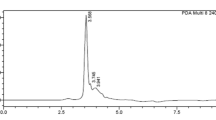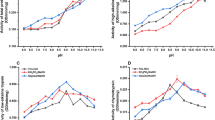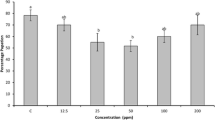Abstract
Spodoptera litura is one of the major polyphagous pests of agro-economically important crops in Asia, Africa and Europe, causing up to 100% loss in crop production. Recent research in eco-friendly plant based insecticides has attracted the attention of researchers. In this study, protease inhibitors (PIs) from non-host plant Cassia glauca were partially purified, with 73% trypsin inhibitory activity, to assess its anti-insect potential. Larval growth and development parameters were assessed by supplementing this PI in artificial diet at various concentrations (25–800 μg/ml). Bioassay studies revealed the inhibitory potential of this PI. Increasing concentrations of PI produced a decrease in larval duration, larval weight, number of pupae formed from treated larvae, pupal weight, percentage female emergence, fecundity and percentage hatching. Food utilization experiments showed an anti-nutritional effect of PI as relative growth rate, efficiency of conversion of ingested and digested food declined in a dose response manner whereas relative consumption rate, approximate digestibility and metabolic cost increased in larvae reared on PI supplemented diet. Experiments with digestive proteases in vitro showed an inhibition in trypsin and chymotrypsin activity in the insect lumen. In conclusion, these PI proteins might be suitable for insect pest management of food crops.




Similar content being viewed by others
References
Boulter D (1993) Insect pest control by copying nature using genetically engineered crops. Biochemistry 34:1453–1466
Carlini CR, Grossi-de-Sa MF (2002) Plant toxic proteins with insecticidal properties. A review on their potentialities as bioinsecticides. Toxicology 40:1515–1539
Carne PB (1966) Growth and food consumption during the larval stages of Paropsis atomaria (Coleoptera: Chrysomelidae). Entomologia Experimetalis et Applicata 9:105–112
Christeller JT (2005) Evolutionary mechanisms acting on proteinase inhibitor variability. FEBS J 272:5710–5722
Green TR, Ryan CA (1972) Wound-induced proteinase inhibitor in plant leaves: a possible defense mechanism against insects. Science 175:776–777
Hilder VA, Gatehouse AMR, Sherman SE, Barker RF, Boulter D (1987) A novel mechanism of insect resistance engineered into tobacco. Nature 300:160–163
Karban R (2011) The ecology and evolution of induced resistance against herbivores. Funct Ecol 25:339–347
Koul O, Multani JS, Singh G, Daniewski WM, Berlozecki S (2003) 6b-Hydroxygedunin from Azadirachta indica, its potentiation effects with some non-azadirachtin limonoids in neem against lepidopteran larvae. J Agric Food Chem 51:2937–2942
Kumar K, Chapman RB (2006) Sublethal effects of insecticides on the diamondback moth Plutella xylostella (L.). Pestic Sci 15:344–352
Labandeira C (2007) The origin of herbivory on land: initial patterns of plant tissue consumption by arthropods. Insect Sci 14:259–275
Lehane MJ, Billingsley PF (1996) Biology of the insect midgut. Chapman and Hall, London, p 486
Lowry OH, Rosenbrough NJ, Farr AL, Randall RJ (1951) Protein measurement with the Folin phenol reagent. J Biol Chem 193:265–275
Murdock LL, Shade RE (2005) Lectins and protease inhibitors as plant defense against insects. J Agric Food Chem 50:6605–6611
Pauchet Y, Muck A, Svatos A, Heckel DG, Prelss S (2008) Mapping the larval midgut lumen proteome of Helicoverpa armigera, a generalist herbivorous insect. J Proteome Res 7:1629–1639
Paulino da Silva L, Leite JRSA, Bloch C Jr, Maria de Freitas S (2001) Stability of a black eyed pea trypsin/chymotrypsin inhibitor (BTCI). Protein Pept Lett 8:33–38
Silva CBLF, Alcazar AA, Macedo LLP, Oliveira AS, Macedo FP, Abreu LRD, Santos EA, Sales MP (2006) Digestive enzymes during development of Ceratitis capitata (Diptera: Tephritidae) and effects of SBTI on its digestive serine proteinase targets. Insect Biochem Mol Biol 36:561–569
Tamhane VA, Chougule NP, Giri AP, Dixit AR, Sainani MN, Gupta VS (2005) In vitro and in vivo effects of Capsicum annum proteinase inhibitors on Helicoverpa armigera gut proteinases. Biochim Biophys Acta 1722:156–167
Telang M, Srinivasan A, Patankar A, Harsulkar A, Joshi V, Damle A, Deshpande V, Sainani M, Ranjekar PK, Gupta G, Birah A, Rani S, Kachole M, Giri AP, Gupta V (2003) Bitter gourd proteinase inhibitors: potential growth inhibitors of Helicoverpa armigera and Spodoptera litura. Phytochemistry 63:643–652
Vasudev A, Sohal SK (2013) Bioinsecticidal potential of partially purified proteinase inhibitors from Brassica oleracea (L.) against Spodoptera litura (Fab.) (Lepidoptera: Noctuidae). Efflatounia 13:1–7
Waldbauer GP (1968) The consumption and utilization of food by insects. Adv Insect Physiol 5:229–288
Wheeler DA, Isman MB (2001) Antifeedant and toxic activity of Trichilia americana extract against the larvae of Spodoptera litura. Entomologia Experimentalis et Applicata 98:9–16
Zhao LY, Chen JL, Cheng DF, Sun JR, Liu Y, Tian Z (2009) Biochemical and molecular characterizations of Sitobion avenae-induced wheat defense responses. Crop Prot 28:435–442
Acknowledgements
The authors acknowledge the Department Of Botanical and Environmental Sciences for identifying the seeds. The first author is the recipient of University with Potential for Excellence research fellowship, University Grants Commission under the PhD programme of Guru Nanak Dev University, Amritsar.
Author information
Authors and Affiliations
Corresponding author
Ethics declarations
Conflict of interests
Authors declare that there is no conflict of interests.
Additional information
Publisher’s note
Springer Nature remains neutral with regard to jurisdictional claims in published maps and institutional affiliations.
Rights and permissions
About this article
Cite this article
Vasudev, A., Sohal, S.K. Negative effect of non-host protease inhibitors partially purified from Cassia glauca seeds on developmental physiology of Spodoptera litura. Int J Trop Insect Sci 39, 1–8 (2019). https://doi.org/10.1007/s42690-019-00001-0
Accepted:
Published:
Issue Date:
DOI: https://doi.org/10.1007/s42690-019-00001-0




